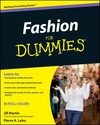All About the Fabrics...
How to Tell Differences among Fabrics and Fabric Blends
Given the relatively limited number of fibers — manmade and synthetic — that are used to make clothing, you may wonder how there can be so many fabrics. The answer has to do with how a fiber is woven, whether the fibers are blended, and what finishes are applied.
Defining features of clothing fabrics
Here’s a quick look at the different fabrics and the weaves that can be constructed from them. It’s a good idea to become familiar with these fabrics (at least on a general level) so you know what you’re looking at the next time you’re deciding between garments.
-
Boucle: A plain or twill weave made from looped yarns that give it a textured, nubby surface.
-
Broadcloth: A fine, tightly woven fabric, either all cotton or a blend, with a slight horizontal rib.
-
Brocade: A decorative cloth that is characterized by raised designs. It’s usually made of silk, sometimes supplemented by actual silver or gold threads.
-
Calico: A plain-weave cotton fabric printed with small motifs.
-
Cashmere: A wool, woven from the fleece of the Cashmere goat, that is both very soft and exceptionally warm. Because of the difficulty of separating the fine fibers from the surrounding coarse hair, cashmere is a luxury product.
-
Chantilly lace: Lace with a net background and floral design patterns created by embroidering with thread and ribbon.
-
Chiffon: A lightweight, extremely sheer and airy fabric with highly twisted fibers. Often used in full pants and loose tops or dresses.
-
Corduroy: A fabric, usually made of cotton or a cotton blend, that uses a cut-pile weave construction. The wale is the number of cords in one inch.
-
Crepe: A fabric that has a crinkled, crimped, or grain surface and that can be made from several different materials. Crepe de chine is made of silk and comes in various widths, with 4-ply considered the most luxurious.
-
Duck: A closely woven, plain, or ribbed cotton fabric that is very durable. It’s similar to canvas but lighter in weight.
-
Dobby: A decorative weave that has small patterns, often geometric.
-
Faille: A closely-knit fabric that is somewhat shiny and has flat, crosswise ribs. Faille can be made from cotton, silk, or synthetics.
-
Gabardine: A twill weave, worsted fabric that can be made from wool, cotton, rayon, or nylon, or blended, with obvious diagonal ribs.
-
Gingham: A fabric made from various yarns, most often in a checked pattern.
-
Herringbone: A twill weave with a distinctive zigzag effect.
-
Microfibers: An extremely fine synthetic fiber that can be woven into textiles with the texture and drape of natural-fiber cloth but with enhanced washability, breathability, and water repellency.
-
Satin: A lustrous fabric most often used in evening wear.
-
Spandex: A stretchy fabric that offers comfort, movement, and shape retention. It is also known by its brand name Lycra (created by DuPont).
-
Taffeta: A crisp, tightly woven fabric with a fine crosswise rib that’s easily identifiable by the rustling sound that it makes. Originally all taffeta was made from silk, but today it can be made from a variety of synthetic fabrics, sometimes combined with silk.
-
Velvet: A luxurious fabric once exclusively made from silk but that today can be composed from a number of different fabrics including cotton. The dense loops, which may or may not be cut, give it a plush feel.
What makes up fabric blends
Blending fibers in a fabric can help prevent wrinkling or lower the cost of a garment. Here are a few examples of blends and their advantages:
-
Polyester and cotton: Polyester is crease resistant; cotton isn’t. A garment that blends the two may not need to be ironed or will require less ironing, while retaining much of the comfort provided by cotton.
-
Linen and silk: Linen creases easily while silk doesn’t. By adding silk to linen, a garment won’t crease as readily and will drape better.
-
Spandex and cotton: Spandex is stretchy and durable, and cotton lets your skin breathe. The two make a perfect combination for sports clothing.
-
Cotton, polyester, and rayon: Cotton offers breathability, polyester strength, and rayon shininess. A fabric with all three offers durability, ultra-softness, and excellent resilience so that if wrinkled, the fabric bounces back.



Leave a comment